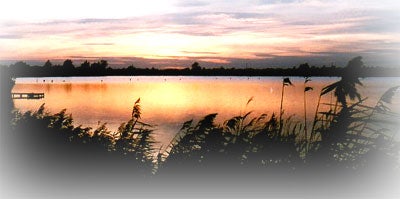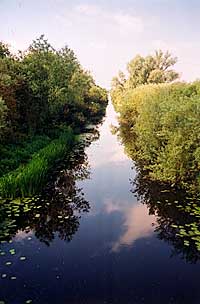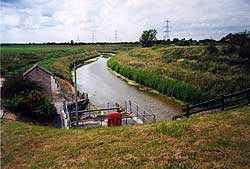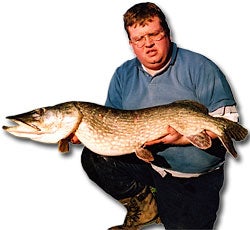Journalist and predator angler Chris Bishop fell in love with the Fens when he moved to Norfolk five years ago. In a new monthly series, exclusive to FISHINGmagic, he gives us a glimpse of this unique landscape and some of the characters who fish it.
I thought I saw the sun coming up a minute or two back, as we raced the dawn down a nameless by-road. It’s one of those days when it struggles to get light and even the lazy wind’s having a lie-in. A mile or two later and we’re peering over the flood bank at a land drain miles from anywhere, rings of topping bait fish spattered blood red by the sunrise. Welcome to the Mad Drain. We call it the Mad Drain, because the first time I brought a mate here a couple of years back, he took one look at it and said: “You’re mad fishing that…” Since then, it’s done several 20s. Even bigger fish are rumoured to have been caught. Maybe not quite so mad after all then. It’s 20 feet wide for the most part and three or four feet deep. Who owns it is a bit of a grey area, so you fish it until someone comes along and points out the error of your ways and avoid the bit around the farm with the two alsatians. The pike are usually just as keen to have a go. But don’t worry – I haven’t been chased down the road by one yet. Lure fishing’s the best way to explore these smaller drains. With little in the way of obvious features, the fish could literally be anywhere. Mind you bridges like this one are usually as good a place as any to start. I bet there’s a pike down there, waiting in the shadows to lash out at the next passing meal. First cast, with a jointed Rapala, glances off the brickwork with a plop that echoes off the arch. Let the ripples subside, crank it down and tap the rod so it bumps the bottom as it bumbles back towards us. A shape appears behind the lure as it wiggles back into sight. But it turns away in a flash of green and white as I run out of line and the trace swivel hits the tip ring. See, there are fish in here all right. Next cast I nail it. All six pounds of it. But just look at the depth of a fish which clearly doesn’t go short of a square meal.
Fishing drains like this is hardly rocket science. All you’ve got to do is keep off the skyline. Or lob the lure so far your bankside stumblings don’t frighten the fish off. The tally’s around half a dozen each, between two and eight pounds, by the time we pause to compare notes over a cuppa and a smoke. Not a bad hour’s work on a crisp February morning. I’ve got a feeling that once the full force of the sun hits the water the pike will lose interest. Dawn and dusk are so often the best times on these shallower drains. So shall we sling the rods in the car and try somewhere down the road..? Drains like this are my confidence boosters, I don’t mind admitting it. I’ve got half a dozen up my sleeve, reserved for times when the blanks begin to merge into one another and I start to think I’m losing the plot as I sit behind a battery of deadbait rods. There are days when you just want to catch something and convince yourself you can still do it. On days when my confidence can’t stand another beating I know where I’ll head for. The Mad Drain’s stuffed with pike. I’ve even caught zander in it. Yet those who drive past it on their way to better-known waters don’t even know they’re there. However daft it looks, the little land drains can sometimes offer the cream of Fen fishing. The best fish I’ve had off this jack-infested ditch was around 12lbs but we can all dream. Oddly enough, some of the smallest drains in the Fens have thrown up some of the biggest pike. Just ask Dennis Moules. Dennis ‘Digger’ Moules Dennis, aka Digger, is a retired copper and a stalwart of the Cambridgeshire branch of the Pike Anglers Club. Since he packed in feeling collars, he’s turned his detective skills to compiling a list of all the 30lbs-plus pike caught on the Fens – when he isn’t out there trying to catch one for himself. Fish of legend top the list, a 52 and a 42 caught from Whittlesey Mere in 1851 and 1875 respectively. The Mere has long since been drained, potato fields and a sea of peat now lie where monsters like these once swam. Colonel Atherton’s 36:04 monster resides in the bar of the Lamb and Flag, at Welney, taunting locals and visitors alike with its glassy stare. Whenever friends visit to sample the Fens, I take them in to marvel at its bulk – preserved for posterity over the fireplace, with a yellowing newspaper clipping and the bung and snap tackle which hauled it into the history books for company. I’ve lost count of the times I’ve dreamed and schemed, desperate for a fish to rival it. I used to think it would only be a matter of time, give it long enough and I’d catch a pike to rival the Colonel’s. Now I’m not so sure. Between its capture in 1957, and March 2002, a further 45 fish over the magical weight are listed. While the 1950s and 60s saw periods of several years between fish of this size, the last few years have seen them out at the rate of three or four a year. But that doesn’t mean there are more of them around today than there were in Col Atherton’s day. Several recent entries are in fact repeat captures, including one pike which has been caught at least nine times, four of them over 30lbs. I’ve been there myself, twice catching a fish others have landed over the magical weight, only to be robbed by the scales. Dennis probably smiled to himself when I told him this, before he replied in a fenman’s thoughtful tones, steeped in black soil burr.
“All we can judge is that with better conservation and angling practices, the fish are getting a better chance,” said Dennis. “But as far as I’m concerned, the chances of catching a 30 are as remote as ever.” Even Bill Chillingsworth, who had caught nearly 300 twenties the last time Dennis asked him, has never managed a Fenland 30. Nor has Dennis, whose own tally of 20lb-plus fish is now nudging the 100 mark. Studying the list reveals another interesting development. Between the 1960s and 1980s – an era regarded by most as the golden age of Fenland piking – the big fish came from big-name waters like the Great Ouse, Relief Channel and Sixteen Foot. Such waters were made famous by the exploits of great pikers of the period like Barrie Rickards, the late Ray Webb, Bill Chillingsworth, the Reynolds brothers, and Neville Fickling. In the last 20 years, less well-known waters have come to the forefront – if you read between the lines – and a new phenomenon has arrived. Several 30s have come from tiny land drains, which collect water off the fields and pump it into the main drains and rivers. The sort of places 90 per cent of people drive by without giving them a second glance, in other words. Just like the Mad Drain. When you boil it down, it all makes sense. They pump water into the same drains from the main drains and rivers in the summer, to irrigate the fields. Most of them are full of hand-sized prey fish. So any pikelets that get sucked into them have plenty to eat. From time to time one rockets to mega weight. But that doesn’t make it any easier to locate a Fenland 30, lost like a needle in a haystack amid mile upon mile of featureless dykes, lodes and land drains. “I’ve fished specifically for fish on that list,” Dennis went on. “The average angler’s chances of catching a 30 are remote, but 20s are different. “Any run of the mill Fen angler should be able to catch a 20 if they do the work and put the hours in. “You’ve got to leap frog miles of drains. And you’ve got to do it when the conditions are right.” Like most pikers, Dennis has his own theory of what makes for ideal conditions, a combination of weather and water conditions when even the breeze that blows through the reeds seems to whisper pike. “You want a warm south-westerly wind, with a bit of colour and flow, a nice ripple on the water and the temperature coming up,” he said. It was just like that one February day when I went out with Phil Pearson. Phil Pikey to his mates. Piking with Phil Pearson Sworn to secrecy and more than a little sceptical, I creep up the bank with Phil. When he isn’t managing a busy MacDonald’s in King’s Lynn, Phil’s a roving piker, who spends his days off touring likely spots. We’ve already tried a drain or two, rattling around the lanes in Phil’s old van, and had the obligatory couple of jacks and a low double. Now we’re off to a secret squirrel banker spot, on part of a drain I’ve never fished, which a couple of Phil’s mates have been baiting up. I’m sceptical, because it’s never worked for me. But to be honest, I’d never made more than a half-hearted go of it, lobbing left-over baits in on a Sunday afternoon in the hope the favour would be returned. Phil’s on a promise. He reckons we’re guaranteed to catch. His mates have been piling 6lbs of fish a week into a swim on an otherwise barren stretch of drain and they’ve caught several topping 20lbs. Sneak it on there and they’re bound to be up for it. We’re crouching on the steep banks five minutes later, holding a single rod each in a parrot cage of a swim among the overhanging trees. I’m doing my best to get comfy, sitting on my unhooking mat, when there’s a huge swirl down the drain. Then the water erupts in the next swim. And then we see it, a big pike rolling around on the surface in the afternoon sun. Maybe there’s something in this after all, I start thinking. Maybe it heard us coming. Maybe it thinks it’s dinner time. “The last time I saw a big pike do that I caught it,” I brag to Phil. Now I’m confident. Cocky, almost. “It’s got to be a good 20,” I said. “look at the size of it.” Phil’s not convinced. “Don’t think it’s that big mate – mid double maybe,” he shrugs, without taking his eyes off his float.
The pike must have got a gob-full of air as it surfaced. I tighten my grip on the rod as a string of tiny bubbles come up around my float. Come on baby. Come on baby. My heart’s in my mouth as the fluorescent tip shivers, it must have brushed against the line. But the orange float settles again, without going under. Then the bubbles head for Phil’s float, which bobs and disappears. Phil winds into it and jumps to his feet as the rod slams over. Braid creaks in the rings and swirls the size of bin lids rock the surface. Phil’s not taking any prisoners but it kites off across the drain and a great mouth appears as it comes on top, gills flared, trying to shake the hooks free. The smelt flies clear but Phil’s hooks stay put. Then it’s on its way to the net I’ve already sunk in the margins, head over the draw cord, shoulders in, I grab the spreader block and the draw cord as a great tail flaps the surface and it’s there. “Told you it was a 20,” I said, heaving the net up the bank. “I reckon it’s nearer 25.” Phil whips the hooks out and she’s on the Avons. Ounces under 25. A quick picture, back she goes and before I’ve even had time to wish I’d caught it my float’s gone. I wonder if it’s the same fish. But my rod pulls round into a far less alarming curve than Phil’s rod did a few minutes earlier. Then the float reappears, it’s on the top and Phil scoops an upper double, probably around the 17 – 18lb mark, into the net. As I slip her back the drain starts pumping and the magic’s gone. Before we can get another bait in, it’s running off too hard to fish from our narrow perch. As we gather up the rods to go, Phil throws our unused baits in and phones his mate on his mobile to thank him for the tip. I’m not feeling quite so cocky now. You can find Dennis Moules’s list of Fenland 30s on the Ely/Fenland PAC website www.elyfenlandpac.co.uk Thanks to Colin Brett, Mark Williams, Chris Hammond and Phil Pearson for some of the photographs used throughout this series. More fascinating facts about Fenland fishing from Chris next month |

















